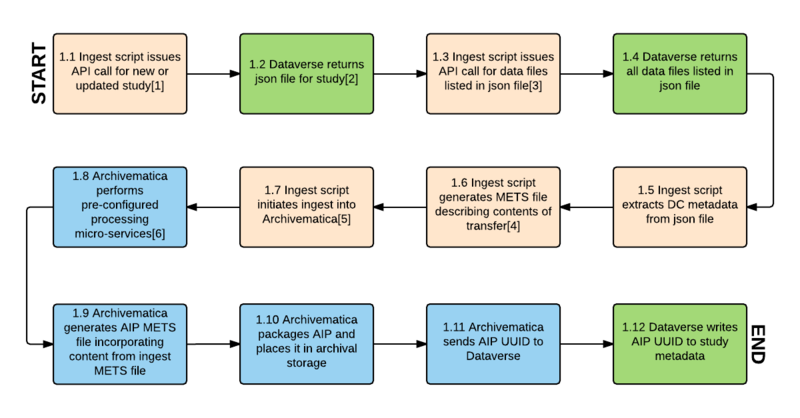Difference between revisions of "Dataverse"
| Line 7: | Line 7: | ||
* [[Sword API]] | * [[Sword API]] | ||
* [[Dataset preservation]] | * [[Dataset preservation]] | ||
| + | |||
| + | ==Overview== | ||
| + | This wiki captures requirements for ingesting studies (datasets) from Dataverse into Archivematica for long-term preservation. | ||
==Workflow== | ==Workflow== | ||
| Line 14: | Line 17: | ||
[[File:Dataverse-Archivematica_workflow.png|800px|thumb|center]] | [[File:Dataverse-Archivematica_workflow.png|800px|thumb|center]] | ||
| − | ==Workflow diagram notes== | + | ===Workflow diagram notes=== |
[1] A new or updated study is one that has been published, either for the first time or as a new version, since the last API call. | [1] A new or updated study is one that has been published, either for the first time or as a new version, since the last API call. | ||
Revision as of 15:31, 13 August 2015
Main Page > Documentation > Requirements > Dataverse
This page tracks development of a proof of concept integration of Archivematica with Dataverse.
See also
Overview
This wiki captures requirements for ingesting studies (datasets) from Dataverse into Archivematica for long-term preservation.
Workflow
Workflow diagram
Workflow diagram notes
[1] A new or updated study is one that has been published, either for the first time or as a new version, since the last API call.
[2] The json file contains citation and other study-level metadata, an entity_id field that is used to identify the study in Dataverse, version information, a list of data files with their own entity_id values, and md5 checksums for each data file.
[3] If json file has content_type of tab separated values, Archivematica issues API call for multiple file ("bundled") content download. This returns a zipped package for tsv files containing the .tab file, the original uploaded file, several other derivative formats, a DDI XML file and file citations in Endnote and RIS formats.
[4] Standard and pre-configured micro-services to include: assign UUID, verify checksums, generate checksums, extract packages, scan for viruses, clean up filenames, identify formats, validate formats, extract metadata and normalize for preservation.
[5] DC metadata parsed for the study only, not for individual data files.
